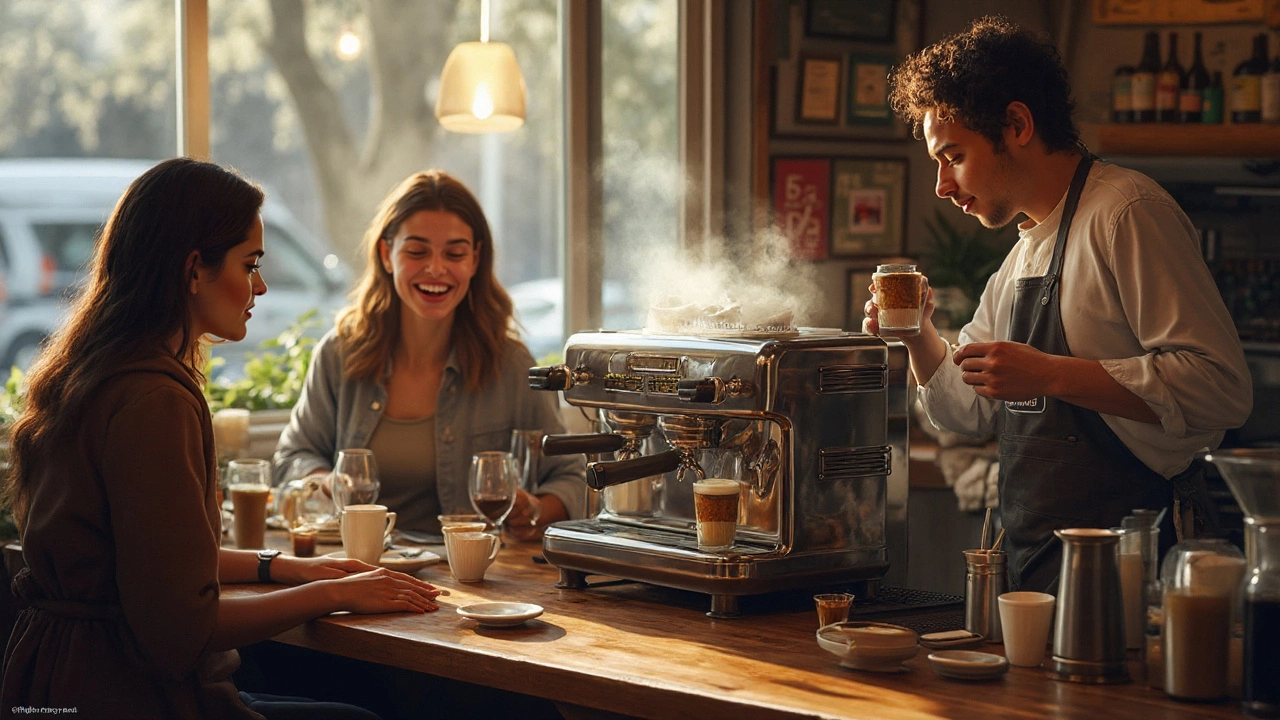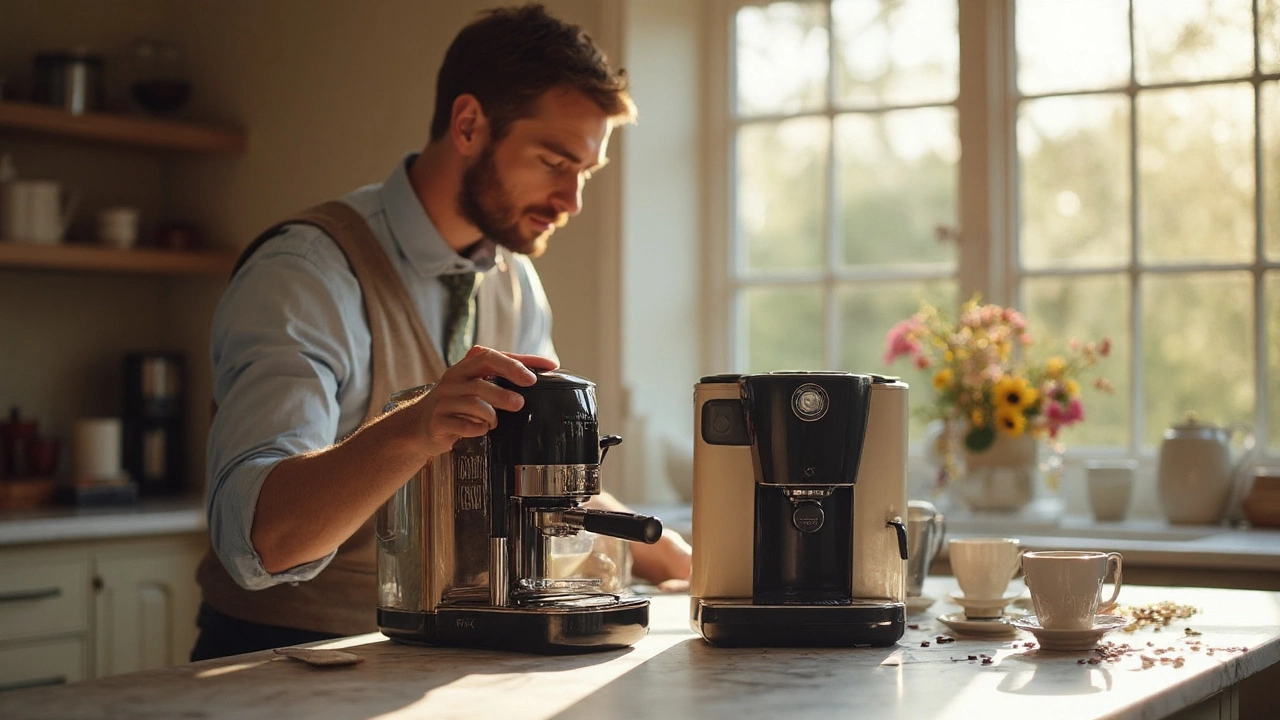Picture this: your alarm goes off, you shuffle to the kitchen half awake, and while you’re still yawning, your coffee maker hums to life. A few minutes later, a cup of rich, aromatic coffee is in your hands—so good, you could swear you’re in your favorite trendy café. But here’s the twist: this magic didn’t come from a $50 drip machine. Instead, you spent more on your coffee setup than you did on your last phone. So, is it worth it? Why would anyone pay hundreds—or even thousands—for a coffee maker?
The Real Differences: High-End vs. Standard Coffee Makers
When someone asks if high-end coffee makers are worth it, what they’re really asking is: Will it make my daily cup better, and why does it cost so much more? At a glance, every coffee maker seems to do the same basic job. But, crack one open and you’ll realize these machines play a different league. The heart of a high-end coffee maker lies in its precision: top models from brands like Technivorm Moccamaster, Breville, and Jura control temperature down to the degree and maintain perfect pressure throughout the brewing process. That’s not just showing off—coffee nerds (and science) agree the sweet spot for extraction sits between 195°F and 205°F. Most budget brewers don’t come close to holding steady at these temps, which leads to sour or bitter flavors.
High-end machines also boast metal internals, quality heating elements, commercial-grade pumps, and burr grinders built in, so the grind is even every time. Some, like the legendary Linea Mini by La Marzocco, use dual boilers: one for steam, one for brewing, so your espresso never gets cold. If you tinker with recipes, they’ll let you customize settings—pre-infusion time, flow rate, coffee strength—things budget models can’t do. Ever seen a $40 drip brewer that syncs with your phone, remembers your favorite brew recipe, or grinds beans moments before brewing? Me neither.
But there’s something else: durability. Years ago, a friend gave up the fifth $80 brewer that died on him in under three years. He bit the bullet and got a Moccamaster. Ten years later, it’s still running, he just changes the filter and descalers once in a while. When you buy high-end, you’re paying for this long game. Most luxury coffee machines are built to last a decade or longer with basic care. But cup after cup, will you really notice the taste? Blind taste tests by America’s Test Kitchen and Consumer Reports found most coffee drinkers preferred coffee made on pricier machines—especially when using fresh beans. So, if you’re chasing the perfect cup, the answer is already peeking through.
Features You Only Get with High-End Coffee Makers
Here’s where high-end coffee makers really start to flex. Gone are the basic on/off switches—welcome to a world where everything’s dialed in. The first thing you’ll notice is temperature stability. Machines like the Breville Barista Express Impress use digital temperature controllers (PID), keeping water within a degree of your set target. This kills the two biggest cup-ruining culprits: under-extraction and bitterness from too hot or too cool water.
If you’re an espresso fan, you’ll love pressure profiling—a feature on machines like the Rocket Appartamento or Profitec Pro 700. You can adjust the pressure curve during extraction, imitating what top baristas do. Don’t care about flexing your barista muscles? Automatic milk steamers—like those on the DeLonghi Dinamica Plus—take milk straight from the carton and whip up microfoam so luscious it looks painted. This takes the stress out of making cappuccinos or lattes, even if you’ve never held a milk jug.
There’s also the convenience of built-in grinders, which isn’t just a gimmick. Whole beans stay fresh longer than ground coffee, and a good burr grinder means uniform particles, so extraction’s more even. Having one inside the machine means you’ll actually use it, since you’re not messing with a separate grinder and a cloud of coffee dust on your counter.
Many high-end brewers, like Miele’s countertop models, offer Wi-Fi connectivity. You can schedule a brew, adjust parameters, or check cleaning reminders right from your phone; some even use sensors to warn you if your water tank is low. Full automation is another perk: set your strength, cup size, and temperature once, and the machine remembers it. Say goodbye to the morning shuffle of buttons and dials.
Then there are specialty brew modes—cold brew, iced, pour-over style, even “bloom” features that mimic what you’d do at a coffee shop. With a machine like the Bonavita Connoisseur, give your grounds a gentle shower, perfect for lighter roasts. And let’s not forget aesthetics: brushed steel, minimalist designs, touch screens—it’s kitchen jewelry.
Some people swear by the silent pumps and insulated carafes these machines offer, meaning hot coffee stays hot for hours, and you won’t wake up the whole household. Want to impress your morning guests? These are the kinds of details only the high end delivers.

Real World Value: Who Actually Benefits from High-End Machines?
Who should actually cough up for one of these? Here’s the honest answer: if you drink coffee every day, care about flavor, and don’t want appliances that die after two years, luxury machines might pay for themselves. Heavy coffee shop goers could save hundreds a year making café-grade drinks at home—even after dropping $800 on a machine. Pull two lattes a day instead of buying at $6 each, you’ll break even in less than a year.
But not everyone needs one. If your taste buds can’t tell Folgers from a specialty roast, skip it. The real magic happens when you toss fresh, quality beans into a high-end brewer. The machine can’t fix stale or bad coffee. If convenience is your thing and you want just a decent, hot cup without fuss, a mid-range brewer will make you happy.
However, for anyone who values customization, precision, or wants to experiment—dialing in grind size, playing with temperature curves, or replicating café favorites—you’ll find endless fun with these machines. Serious home baristas even get tools: pressure gauge feedback, pre-infusion controls, or bottomless portafilters for espresso practice. Some models make enough coffee for family or hosting brunches, others have smaller footprints for tight spaces.
There’s also pride in ownership. Ever talked to someone who loves their Technivorm or Rancilio Silvia? They’ll bend your ear about café-quality crema, the right water hardness, or how they never go to Starbucks. And with high resale value for well-kept machines, you don’t lose your investment if you upgrade or move. Don’t forget, too, high-end brands stand behind their hardware—many offer warranties for 5-10 years and have service parts available. This isn’t true for most off-the-shelf department store brewers.
Got a big family, or partner with wildly different taste? Some premium machines brew two cups at once with dual spouts, or save multiple user profiles. There’s usually less plastic, fewer single-use pods, and less waste, so the eco-conscious can feel better about their daily habit, too.
Tips for Getting the Most from Your High-End Coffee Maker
If you do make the jump to the high-end club, don’t just plug it in and walk away. Here’s how to get your money’s worth:
- Buy the freshest beans you can from a reputable roaster. Even a $2,000 espresso machine can’t fix stale beans. Start with a good single origin or house blend and experiment with different roast profiles to suit your taste.
- Grind just before brewing. Use a burr grinder, preferably one built into your machine or a standalone model, and adjust the grind size according to your brew method (finer for espresso, coarser for French press).
- Filter your water. Even a cheap filter pitcher will make a difference. Hard or chlorine-heavy water ruins flavor and shortens the life of the heating element. Test strips are a few bucks, and many machines now have reminders to keep water quality in check.
- Clean relentlessly, but don’t stress—it’s not as high-maintenance as people make out. Most high-end brewers have indicator lights for descaling, and removable parts that go into your dishwasher. Stick to manufacturer schedules, and use de-scaler recommended by your machine’s maker.
- Read the manual. Sounds boring, but a lot of folks overlook useful features. Maybe there’s a trick for pre-warming your cup, or a hidden menu to adjust flow rate. Even an extra minute making adjustments can make a huge difference to taste.
- Track what you like. Jot down your recipes: grams of coffee, ounces of water, temperature, valve settings. Next time you land a perfect cup, you’ll know how you did it.
- Don’t be afraid to experiment. Try single shot versus double, cold foam versus hot, or swap milk types for different flavors. The great thing about high-end gear is you control the process, so have fun with it.
Longevity depends on care. Replace seals and gaskets every couple of years, and store your machine somewhere dry. If your machine has connectivity, check for firmware updates—sometimes they improve performance or add features. Register your gear for warranty coverage, and don’t hesitate to ask the brand’s support about parts or troubleshooting; high-end companies want loyal customers and usually go the extra mile.
If you ever think the machine isn’t delivering, try a side-by-side taste test with a friend’s basic brewer using the same beans and water. The difference will be obvious—unless your kitchen karma is way off that day.
So, are high-end coffee makers worth it? If excellence, reliability, and the ritual of a perfect cup matter—or you’re ready to ditch daily coffee runs for good—then yes, you’ll get your money’s worth. But don’t just take my word for it—run the numbers, taste the results, and give your taste buds the upgrade. Your mornings might never be the same.

